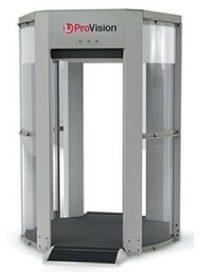
Initially the TSA was going to use the whole body scanning machines that use either the backscatter technique, or the new strip-searching millimeter wave method (compare methods replete with photos) as a secondary option instead of physical pat-downs and the electronic wand. But in their October 17, 2008, privacy impact assessment the text reveals that the intent was to evaluate the WBI technology for primary screening. This belies the TSA acting chief’s claim that it was the machines’ excellent performance that has changed the agenda.
TSA acting chief Robin Kane said, “We’re just finishing some piloting in six airports in the primary screening position,” and results were positive both in terms of effectiveness and “feedback from passengers.”
Kane claims the WBI process is just as quick as metal detectors. TSA spokeswoman, Sterling Payne said, “It’s very, very quick; the scan is about two seconds.” They’ll tell you the position to stand in, there’s the quick scan, and then you step out of the machine and wait for the resolution, which happens in a separate room in another part of the checkpoint.”
But traveler Laura Holmes Jost, of Miami Beach, disagrees and relates:
They asked me to walk into it and pointed to the spots on the floor to put your feet. They had me raise my arms up, and then the man walks out of the machine, the doors close, it whirs around like you’re getting an X-ray, the door opens.
Then the man asked me to turn to my side and there was another pair of footmarks on the floor for you to stand on. The doors close, whirs around again, the door opens and you stand outside while the man waits to get notification from a light on front of the machine, which I guess is the person at the remote location saying, "O.K., she’s clear."
It took more like two minutes.
The WBI technology transmits an almost naked but slightly metallic image to a screener who is not visible to the passenger, in a separate location at the checkpoint to supposedly eliminate any association between the two, and clearance is signaled back by an electronic green light. The TSA says that the images can be adjusted to distort faces and private body parts, and that the images will never be stored. They also insist the images are not pornographic. But blurring private body parts would limit detection capabilities, so the blurring will probably not happen.
In airports where the whole-body imaging machines have been tested, Kane reports that less than 2 percent of passengers presented with the option of using them are choosing not to. But how many are presented with the option, and is the other option a physical pat-down?
TSA wants to replace the old detectors with the new naked machines some time this summer. In the meantime, they have a happy little blogger named “Bob” who attempts to diffuse any objections and commentary on TSA’s blog and who, (Blogger Bob) for propagandizing purposes, adds his comments to promote the TSA party line to online pieces on the Internet.
The chances and probabilities for abuse to occur both in the storage and possibility of distribution of images is astronomical, not to mention the voyeuristic perverts who might be attracted to the job of viewing naked pictures of strangers, women, children, and even religious persons all day long, but most important is the loss of personal privacy.



